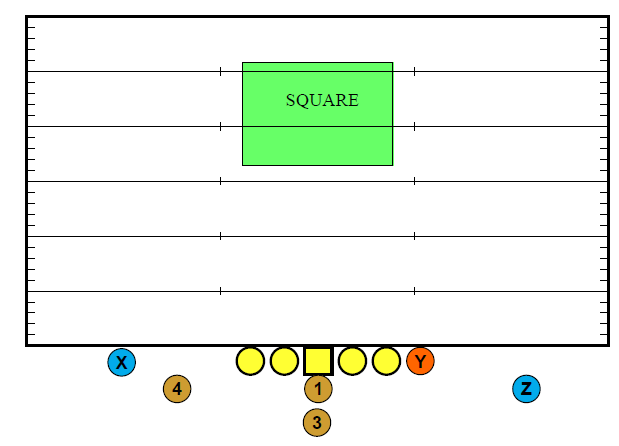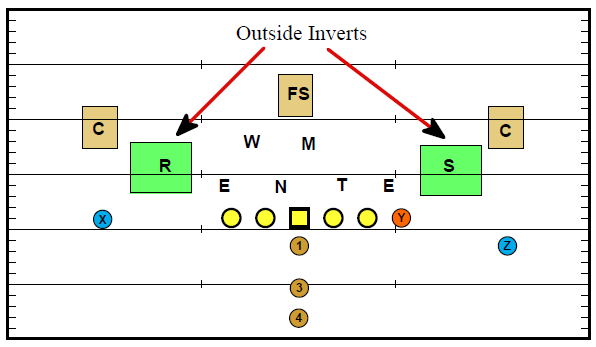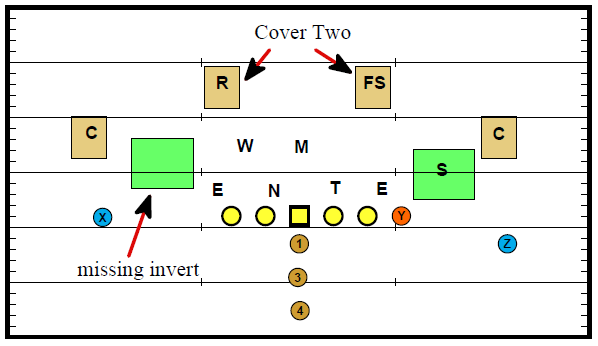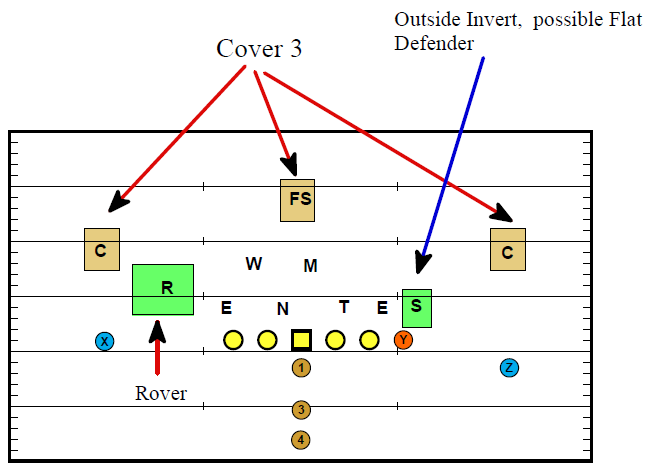Stance
The quarterback mechanics starts with the stance. When the quarterback is in the gun or pistol, he will align with his heels at five yards for the gun and 3 yards for the pistol directly behind the center. The knees should be slightly bent in an athletic position, with a slight stagger (left foot back for the right-handed quarterback) with the head and eyes up. The hands should also be up in a position to receive the ball, even if the Pre-Snap Read process has not yet been completed. There are two reasons for this, (1) the defense will not stem or reveal their intentions as long as the quarterback has a chance to knock down a bad snap.
Reads
The quarterback (“QB”) should always Pre-Snap Read (“PSR”) by looking at the defense. In addition, the QB will read personnel in coverages as the play develops by Reading on the Move (“ROM”), but this should be based upon a progression. The receiver progression is based upon the pre-snap read. The pre-snap read procedure is for the quarterback to formulate possible defensive sets that he might expect the defense to play and determine if the defense has the offense out numbered at the point of attack (“P.O.A.”). The quarterback will approach the line looking to the left, middle and right using a soft gaze technique (a rhythmic scan of the field) without giving away the direction of the play. He will read from sideline to sideline to determine (1) depth of the corners, (2) number of safeties, (3) weak side flat defender and, (4) the front (number of rush defenders). The true read will only take place when the quarterback is in a position to receive the ball; i.e., hands under the center when in the “I” or hands up when in the Pistol and Gun.
On the snap of the ball, the quarterback will read the focus area (progression) based upon the pre-snap read. The technique used is a “Hard Focus”, which is a rhythmic fix on a specific defender or zone. The “reading on the move” should allow the quarterback to find the “Line of Sight” to avoid the defense. The line of sight allows the quarterback to see the (read) the defender(s) while the receiver’s route develops. The initial focus area (first two steps) is through the linebackers to the goal post. If the linebackers are moving laterally, then it is possible man coverage (underneath); if the linebackers are dropping back, the read is zone coverage. The reason for looking through the goal post is to see if a safety is at home; i.e., three (3) deep zone or man free. If there is no secondary person, then it is possible two (2) or four (4) deep zone, maybe even a man depending on the pre-snap read. Also, the quarterback can see any rotation by the secondary when reading through the goal post. The quarterback then uses a “hard focus” in the throwing direction. The throwing decision is based upon what the quarterback sees in the “line of sight”.
Drops
Drops are a critical component to throwing the football – that is why the gun and pistol is so effective. The sooner the quarterback is set to throw, the more time he has to look over the field. Having the time to read the “line of sight” as the pass pattern develops (progression) will help the completion average.
When a quarterback is throwing out of the pistol or gun, we say (gun equals one and pistol equals two”. This means that if a pass pattern typically requires a 3-step drop, then the quarterback will execute a 1-step drop, and if the pattern calls for a 5-step drop, then the quarterback will execute a 3-step drop. The footwork for the quarterback’s drops are exactly the same as if he were under center.
Here is an overview of the 1 and 3-step drop mechanics:
1 – Step Drops – The basic footwork is a bounce step back and throw. The quarterback must catch the ball and throw. The 1-step is typically a short throw, that requires timing, so don’t waste time searching for the laces. It is very important that the quarterback tuck using the stomach muscles to keep the “chin and spine” angle in neutral. If the “chin and spine” angle is back, there is a high probability that the throw will be high.
3 – Step Drops – In the Gun and Pistol, the three-step drop is used most of the time. The basic footwork is:
Separation Step
Stride as deep as comfortable.
Pivot on the staggered foot and take a long step back toward the Passing Spot.
The head and eyes should be straight down field.
The “Chin & Spine” angle should be back.
Alignment Step
Use a crossover step with the front foot to six o’clock.
Foot should be at a slight angle away from the line of scrimmage (“LOS”) when passing to the
throwing arm side and toward the line of scrimmage when throwing.
The head and eyes should be straight down field.
Work for body control and balance.
The “Chin & Spine” angle should be forward.
Plant
Hit your back foot and throw and hang.
Hang is executed by keeping the front foot up in the air for a moment to buy some extra time for
the receivers to clear.
The step may drift past the midline when throwing to the arm side.
The “Chin & Spine” angle should be forward.
Sprintout
The emphasis here is to get the quarterback outside the containment and throw the ball on the run. There will be time when the quarterback sets his feet (“pulls up”) once he breaks containment. The quarterback throws off his third, fifth, seventh, or ninth step when he runs to the throwing arm side. The delivery begins as the wrong foot (left for a right-handed quarterback) hits the ground with the release of the ball the normal (right for a left-handed quarterback) foot hits the ground. The ball must be in a ready position on the second step so the quarterback can begin the throw quickly. If the release occurs before an “odd” number of steps, the throw will be across the body.
When coming out to the backside, the technique is similar. But, the quarterback spins or rolls out, rather than opening up. In order to get the quarterback back in rhythm and throwing off his proper foot, the quarterback will release the ball on even steps, four, six, eight or ten. When throwing to the backside the quarterback must lean into the throw on his wrong foot (left for a right handed quarterback).
Reading the Square Understanding Coverages
One method which will be helpful in determining coverages or give the quarterback a hint as to what to expect by reading the square after the ball is snapped, the square is the middle of the field. This can be done by reading areas on the field or by keying defensive individuals after the ball is snapped, usually this is the free safety.
One of the most important areas in determining secondary coverages is the middle of the field about fifteen to twenty five yards deep and about two yards inside each hash. This area is known as the SQUARE.

The square would possibly be a method you would consider teaching in your drop back passing game. Reading the square becomes necessary when it is impossible to determine what the coverage is before the snap, or determine what the coverage was after the snap.
In reading the square the quarterback simply looks down the middle of the field. The quarterback should not focus on either safety but see them both in his peripheral vision.
Reading Outside Overhangs Understanding Coverages
Besides reading the square another method, is reading outside inverts for understanding coverages. With the illustration below the quarterback would read outside inverts in the green area for understanding coverage. In this illustration the quarterback is reading possible cover three.

The illustration below appears to be a cover two or cover four based upon the missing invert towards the openside. The concept of reading outside inverts is an easy method for pre-snap coverage.

Reading The Three Deep Secondary
In reading the three deep secondary, many of the keys of reading the four deep still apply. The major difference between the three deep and a four deep is that the strong safety (Rover) plays to the open or split end side.
The three deep is generally played behind some type of eight man front defense. Normally in a Under or Solid front scheme.
It is usually easier to determine the basic coverage in a three deep scheme before the snap. This is due to the fact that there are only three defensive backs and to get variations in their coverages, they must cheat in one direction or another to get to their responsibilities.
In the example below below, it is safe to assume the coverage will be three deep with very little chance of a roll or cover 2. This is because of the alignment of the safety and Rover. It is obvious the the Rover cannot cover different areas on the field.
The basic adjustment this defense gives is the ability to roll or play cover 2. It is easy to move the Rover out to the open side and rotate the Free Safety to the Flanker side.

About the Author of this post:
Jerry Campbell has over 30 years of high school and college coaching experience. He has experience as a head coach, offensive coordinator, and various position coaches. He has written numerous football coaching articles in various publications, is the author of over 30 books on coaching football, and has produced 12 coaching video series. Additionally, he is a nationally sought after speaker on the coaching clinic circuit.